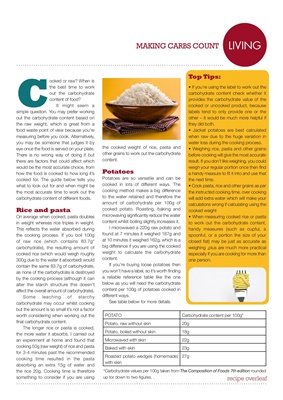
KITLIVING
• If you're using the label to work out the
carbohydrate content check whether it
provides the carbohydrate value of the
cooked or uncooked product, because
labels tend to only provide one or the
other - it would be much more helpful if
they did both.
• Jacket potatoes are best calculated
when raw due to the huge variation in
water loss during the cooking process.
• Weighing rice, pasta and other grains
before cooking will give the most accurate
result. If you don't like weighing, you could
weigh your regular portion once then find
a handy measure to fit it into and use that
the next time.
• Cook pasta, rice and other grains as per
the instructed cooking time, over cooking
will add extra water which will make your
calculations wrong if calculating using the
cooked weight
• When measuring cooked rice or pasta
to work out the carbohydrate content,
handy measures (such as cupful, a
spoonful, or a portion the size of your
closed fist) may be just as accurate as
weighing ,plus are much more practical
especially if you are cooking for more than
one person.
Cooked or raw? When is
the best time to work
out the carbohydrate
content of food?
It might seem a
simple question. You may prefer working
out the carbohydrate content based on
the raw weight, which is great from a
food waste point of view because you're
measuring before you cook. Alternatively,
you may be someone that judges it by
eye once the food is served on your plate.
There is no wrong way of doing it but
there are factors that could affect which
would be the most accurate choice, from
how the food is cooked to how long it's
cooked for. The guide below tells you
what to look out for and when might be
the most accurate time to work out the
carbohydrate content of different foods.
Rice and pasta
On average when cooked, pasta doubles
in weight whereas rice triples in weight.
This reflects the water absorbed during
the cooking process. If you boil 100g
of raw rice (which contains 83.7g*
carbohydrate), the resulting amount of
cooked rice (which would weigh roughly
300g due to the water it absorbed) would
contain the same 83.7g of carbohydrate,
as none of the carbohydrate is destroyed
by the cooking process (although it can
alter the starch structure this doesn't
affect the overall amount of carbohydrate).
Some leaching of starchy
carbohydrate may occur whilst cooking
but the amount is so small it's not a factor
worth considering when working out the
final carbohydrate content.
The longer rice or pasta is cooked,
the more water it absorbs. I carried out
an experiment at home and found that
cooking 50g (raw weight) of rice and pasta
for 3-4 minutes past the recommended
cooking time resulted in the pasta
absorbing an extra 15g of water and
the rice 20g. Cooking time is therefore
something to consider if you are using recipe overleaf
MAKING CARBS COUNT
the cooked weight of rice, pasta and
other grains to work out the carbohydrate
content.
Potatoes
Potatoes are so versatile and can be
cooked in lots of different ways. The
cooking method makes a big difference
to the water retained and therefore the
amount of carbohydrate per 100g of
cooked potato. Roasting, baking and
microwaving significantly reduce the water
content whilst boiling slightly increases it.
I microwaved a 220g raw potato and
found at 7 minutes it weighed 187g and
at 10 minutes it weighed 162g, which is a
big difference if you are using the cooked
weight to calculate the carbohydrate
content.
If you're buying loose potatoes then
you won't have a label, so it's worth finding
a reliable reference table like the one
below as you will need the carbohydrate
content per 100g of potatoes cooked in
different ways.
See table below for more details.
POTATO Carbohydrate content per 100g*
Potato, raw without skin 20g
Potato, boiled without skin 18g
Microwaved with skin 22g
Baked with skin 23g
Roasted potato wedges (homemade)
with skin
27g
*Carbohydrate values per 100g taken from The Composition of Foods 7th edition rounded
up tor down to two figures. .
Top Tips: